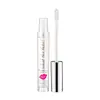What's inside
What's inside
 Key Ingredients
Key Ingredients

 Benefits
Benefits

 Concerns
Concerns

 Ingredients Side-by-side
Ingredients Side-by-side

Bis-Diglyceryl Polyacyladipate-2
EmollientPolybutene
Tridecyl Trimellitate
EmollientDiisostearyl Malate
EmollientHydrogenated Microcrystalline Wax
Emulsion StabilisingDipentaerythrityl Hexahydroxystearate/Hexastearate/Hexarosinate
Skin ConditioningSilica
AbrasiveGlyceryl Behenate/Eicosadioate
EmollientVanillyl Butyl Ether
MaskingSodium Hyaluronate
HumectantTocopheryl Acetate
AntioxidantHydrogenated Jojoba Oil
AbrasiveMica
Cosmetic ColorantEthyl Menthane Carboxamide
TonicEthylhexylglycerin
Skin ConditioningButylene Glycol
HumectantWater
Skin ConditioningVitis Vinifera Seed Extract
AntimicrobialPhenoxyethanol
PreservativeParfum
MaskingCI 77891
Cosmetic ColorantBis-Diglyceryl Polyacyladipate-2, Polybutene, Tridecyl Trimellitate, Diisostearyl Malate, Hydrogenated Microcrystalline Wax, Dipentaerythrityl Hexahydroxystearate/Hexastearate/Hexarosinate, Silica, Glyceryl Behenate/Eicosadioate, Vanillyl Butyl Ether, Sodium Hyaluronate, Tocopheryl Acetate, Hydrogenated Jojoba Oil, Mica, Ethyl Menthane Carboxamide, Ethylhexylglycerin, Butylene Glycol, Water, Vitis Vinifera Seed Extract, Phenoxyethanol, Parfum, CI 77891
Diisostearyl Malate
EmollientPhytosteryl/Isostearyl/Cetyl/Stearyl/Behenyl Dimer Dilinoleate
Skin ConditioningBis-Diglyceryl Polyacyladipate-2
EmollientPolyglyceryl-2 Triisostearate
EmulsifyingHydrogenated Polyisobutene
EmollientCeresin
Emulsion StabilisingMicrocrystalline Wax
Emulsion Stabilising1,2-Hexanediol
Skin ConditioningParfum
MaskingBenzyl Benzoate
AntimicrobialTocopheryl Acetate
AntioxidantPassiflora Edulis Seed Oil
EmollientBenzyl Alcohol
PerfumingVitis Vinifera Seed Oil
EmollientEuterpe Oleracea Fruit Extract
Punica Granatum Fruit Extract
AntioxidantLycium Barbarum Fruit Extract
AstringentMalpighia Punicifolia Fruit Extract
AntioxidantPassiflora Incarnata Flower Extract
Skin ConditioningCitrus Limon Fruit Extract
MaskingCitrullus Lanatus Fruit Extract
Skin ConditioningFragaria Vesca Fruit Extract
AstringentVaccinium Angustifolium Fruit Extract
Skin ProtectingPrunus Persica Fruit Extract
AbrasiveVaccinium Macrocarpon Fruit Juice
Skin ConditioningTocopherol
AntioxidantCI 45410
Cosmetic ColorantCI 15985
Cosmetic ColorantCI 77891
Cosmetic ColorantCI 15850
Cosmetic ColorantIron Oxides
CI 42090
Cosmetic ColorantDiisostearyl Malate, Phytosteryl/Isostearyl/Cetyl/Stearyl/Behenyl Dimer Dilinoleate, Bis-Diglyceryl Polyacyladipate-2, Polyglyceryl-2 Triisostearate, Hydrogenated Polyisobutene, Ceresin, Microcrystalline Wax, 1,2-Hexanediol, Parfum, Benzyl Benzoate, Tocopheryl Acetate, Passiflora Edulis Seed Oil, Benzyl Alcohol, Vitis Vinifera Seed Oil, Euterpe Oleracea Fruit Extract, Punica Granatum Fruit Extract, Lycium Barbarum Fruit Extract, Malpighia Punicifolia Fruit Extract, Passiflora Incarnata Flower Extract, Citrus Limon Fruit Extract, Citrullus Lanatus Fruit Extract, Fragaria Vesca Fruit Extract, Vaccinium Angustifolium Fruit Extract, Prunus Persica Fruit Extract, Vaccinium Macrocarpon Fruit Juice, Tocopherol, CI 45410, CI 15985, CI 77891, CI 15850, Iron Oxides, CI 42090
Ingredients Explained
These ingredients are found in both products.
Ingredients higher up in an ingredient list are typically present in a larger amount.
This ingredient is lipid-based synthetic skin-conditioning agent derived from adipic acid and a mixture of fatty acids. It is often called a lanolin substitute.
As an emollient, it helps soften and hydrate the skin. Emollients create a barrier on the skin to trap moisture in.
Due to its fatty acid base, it may not be Malassezia folliculitis safe.
Learn more about Bis-Diglyceryl Polyacyladipate-2Ci 77891 is a white pigment from Titanium dioxide. It is naturally found in minerals such as rutile and ilmenite.
It's main function is to add a white color to cosmetics. It can also be mixed with other colors to create different shades.
Ci 77891 is commonly found in sunscreens due to its ability to block UV rays.
Learn more about CI 77891Diisostearyl Malate is an emollient and most often used in lip products. It comes from isostearyl alcohol, a fatty acid, and malic acid, an AHA.
As an emollient, Diisostearyl Malate helps create a thin film on your skin to trap moisture in. This helps keep your skin soft and smooth.
Parfum is a catch-all term for an ingredient or more that is used to give a scent to products.
Also called "fragrance", this ingredient can be a blend of hundreds of chemicals or plant oils. This means every product with "fragrance" or "parfum" in the ingredients list is a different mixture.
For instance, Habanolide is a proprietary trade name for a specific aroma chemical. When used as a fragrance ingredient in cosmetics, most aroma chemicals fall under the broad labeling category of “FRAGRANCE” or “PARFUM” according to EU and US regulations.
The term 'parfum' or 'fragrance' is not regulated in many countries. In many cases, it is up to the brand to define this term.
For instance, many brands choose to label themselves as "fragrance-free" because they are not using synthetic fragrances. However, their products may still contain ingredients such as essential oils that are considered a fragrance by INCI standards.
One example is Calendula flower extract. Calendula is an essential oil that still imparts a scent or 'fragrance'.
Depending on the blend, the ingredients in the mixture can cause allergies and sensitivities on the skin. Some ingredients that are known EU allergens include linalool and citronellol.
Parfum can also be used to mask or cover an unpleasant scent.
The bottom line is: not all fragrances/parfum/ingredients are created equally. If you are worried about fragrances, we recommend taking a closer look at an ingredient. And of course, we always recommend speaking with a professional.
Learn more about ParfumTocopheryl Acetate is AKA Vitamin E. It is an antioxidant and protects your skin from free radicals. Free radicals damage the skin by breaking down collagen.
One study found using Tocopheryl Acetate with Vitamin C decreased the number of sunburned cells.
Tocopheryl Acetate is commonly found in both skincare and dietary supplements.
Learn more about Tocopheryl Acetate